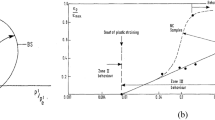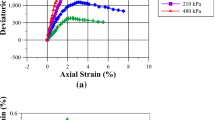Abstract
Cyclic soil degradation and hardening affects soil stiffness and strength, and is linked to an increase or decrease in the mean effective confining stress due to void ratio or pore pressure changes. This change of state can be explicitly modeled by using effective stress methods, or implicitly modeled using total stress methods. In the latter, this is achieved by using empirical functions based on the number of loading cycles that are derived from constant-amplitude stress or strain laboratory tests. To suite generalized loading conditions, these functions must be extrapolated to variable-amplitude loading. This falls under the general class of a fatigue-based problem. The main focus of this paper is to present a generalized consistent soil fatigue formulation for soils under cyclic loading. The paper then goes on to discuss the implementation of various cyclic soil degradation and hardening models reported in the literature, and highlights their important underlying assumptions, capabilities and limitations.








Similar content being viewed by others
References
Allotey NK (2006) Nonlinear soil-structure interaction in performance-based design. Ph.D. thesis, University of Western Ontario, London, Ontario
Allotey NK, El Naggar MH (2006). Cyclic degradation/hardening in total stress analysis: new equations. In: Proceedings of 1st European Conference on Earthquake Engineering and Seismology, Geneva, Switzerland, Paper no. 1015
Andersen KH, Dyvik R, Kikuchi Y, Skomedal E (1993) Clay behaviour under irregular cyclic loading. Norwegian Geotech Inst Pub 189:1–18
Annaki M, Lee KLL (1977) Equivalent uniform cycle concept for soil dynamics. J Geotech Eng Div, ASCE, 103(GT6):549–564
Biondi G, Cascone E, Maugeri M (2004) Number of uniform stress cycles equivalent to seismic loading. In: Proceedings of 11th ICSDEE/3rd ICEGE, pp 705–712
De Alba P, Seed HB, Chan CK (1976). Sand liquefaction in large-scale simple shear tests. J Geotech Eng Div, ASCE 102(GT9):909–927
Finn WDL, Lee KW, Martin GR (1977) An effective stress model for liquefaction. J Geotech Eng, ASCE 103(GT6):517–533
Grashuis AJ, Dieterman HA, Zorn NF (1990) Calculation of cyclic response of laterally loaded piles. Comp Geotech 10:287–305
Green RA, Terri GA (2005) Number of equivalent cycles concept for liquefaction evaluation—revisited. J Geotech Geoenviron Eng, ASCE 131(4):477–488
Hwang W, Han KS (1986) Cumulative damage models and multi-stress fatigue life prediction. J Composite Mat 20:125–153
Idriss IM, Moriwaki Y, Dobry R (1977) Stress–strain behaviour of soft clay in level ground deposits during and after cyclic earthquake loading, normal marine clay, Icy bay area, Gulf of Alaska. Final Report for Shell Development Company, Woodward-Clyde Consultants, San Francisco, California.
Idriss IM, Dobry R, Singh RD (1978) Nonlinear behaviour of soft clays during cyclic loading. J Geotech Eng, ASCE 104(GT12):1427–1447
Lee KL, Albeisa A (1974) Earthquake induced settlements in saturated sands. J Soil Mech Found Div, ASCE 100(SM4):387–406
Lee KL, Chan K (1972) Number of equivalent significant cycles in strong motion earthquakes. In: Proceedings of International Conference on Microzonation for Safer Construction Research and Application, vol 2. Seattle, Washington, pp 609–627
Liu AH, Stewart JP, Abrahamson NA, Moriwaki Y (2001) Equivalent number of uniform stress cycles for soil liquefaction analysis. J Geotech Geoenviron Eng 127(12):1017–1026
Liyanapathirana DS, Poulos HG (2002) A numerical model for dynamic soil liquefaction analysis. Soil Dyn Earthquake Eng 22:1007–1015
Matasovic N, Vucetic M (1993) Cyclic characterization of liquefiable sands. J Geotech Eng, ASCE 119(11):1805–1822
Matasovic N, Vucetic M (1995) Generalized cyclic-degradation-pore pressure generation model for clays. J Geotech Eng, ASCE 121(1):33–42
Matlock H, Foo S, Bryant LM (1978) Simulation of lateral pile behaviour under earthquake motion. In: Proceedings of ASCE Specialty Conference on Earthquake Engineering and Soil Dynamics, vol II, Pasadena, California, pp 600–619
Miner MA (1945) Cumulative damage in fatigue. J App Mech 12(3):159–164
Palmgren A (1924) Die Lebensder Von Kugellagren. Zeitschrift des Vereines Deutscher Ingenieure 58:339–341 (German)
PMB Engineering (1988) Pile Analysis Routines, Theoretical and User’s Manual, PMB Engineering Inc., Berkeley, California
Poulos HG (1982) Single pile response to cyclic lateral load. J Geotech Eng, ASCE 108(GT3):355–375
Pyke R, Beikae M (1993) TESS—A computer program for nonlinear ground response analysis: User’s Manual, Taga Engineering Software Services, Berkeley, California
Rajashree SS, Sundaravadivelu R (1996) Degradation model for one-way cyclic lateral load on piles in soft clay. Comp Geotech 19(4):289–300
Sawant VA, Dewaikar DM (1999) Analysis of pile subjected to cyclic lateral loading. Geotech Eng J, Southeast Asian Geotechnical Society 30(1):25–40
Seed HB, Idriss IM, Makdisi F, Banerjee N (1975) Representation of irregular stress time-histories by equivalent uniform stress series in liquefaction analysis. Report No. UCB/EERC 75-29, University of California, Berkeley, California
Seed HB, Martin PP, Lysmer J (1976) Pore-water pressure changes during soil liquefaction. J Geotech Eng Div, ASCE 104(GT4):323–346
Swane IC, Poulos HG (1984) Shakedown analysis of a laterally loaded pile tested in stiff clay. In: Proceedings of 4th Australia-New Zealand Conference on Geomechanics, Paper no. C1545, Perth, Australia, pp 275–279
Van Eekelen HAM (1977) Single-parameter models for progressively weakening soils by cyclic loading. Geotechnique 27(3):357–368
Van Eekelen HAM (1980) Fatigue models for cyclic degradation of soils. In: Pande GN, Zienkiewicz OC (eds) Soils under cyclic and transient loading. Balkema, Rotterdam, pp 447–450
Van Paepegem W, Degrieck J (2002) Effects of load sequence and block loading on the fatigue response of fibre-reinforced composites. Mech Adv Mat Struct 9(1):19–35
Vucetic M, Dobry R (1988) Degradation of marine clays under cyclic loading. J Geotech Eng, ASCE 114(2):133–149
Yasuhara K, Hirao K, Hyde AFL (1992). Effects of cyclic loading on undrained strength and compressibility of clay. Soils and Found 32(1):100–116
Yasuhara K, Hyde AFL, Toyata N, Murakami S (1997). Cyclic stiffness of plastic silt with an initial drained shear stress. In: Proceedings of Geotechnique Symposium on Pre-failure Deformation Behaviour of Geomaterials, London, pp 373–382
Yoshida N, Yasuda S, Kiku H (2004) Laboratory test of liquefaction characteristics of sand under level-two ground motion. In: Proceedings of 13th World Conference on Earthquake Engineering, Vancouver, BC, Paper no. 492
Author information
Authors and Affiliations
Corresponding author
Rights and permissions
About this article
Cite this article
Allotey, N., El Naggar, M.H. A Consistent Soil Fatigue Framework Based on the Number of Equivalent Cycles. Geotech Geol Eng 26, 65–77 (2008). https://doi.org/10.1007/s10706-007-9147-2
Received:
Accepted:
Published:
Issue Date:
DOI: https://doi.org/10.1007/s10706-007-9147-2




